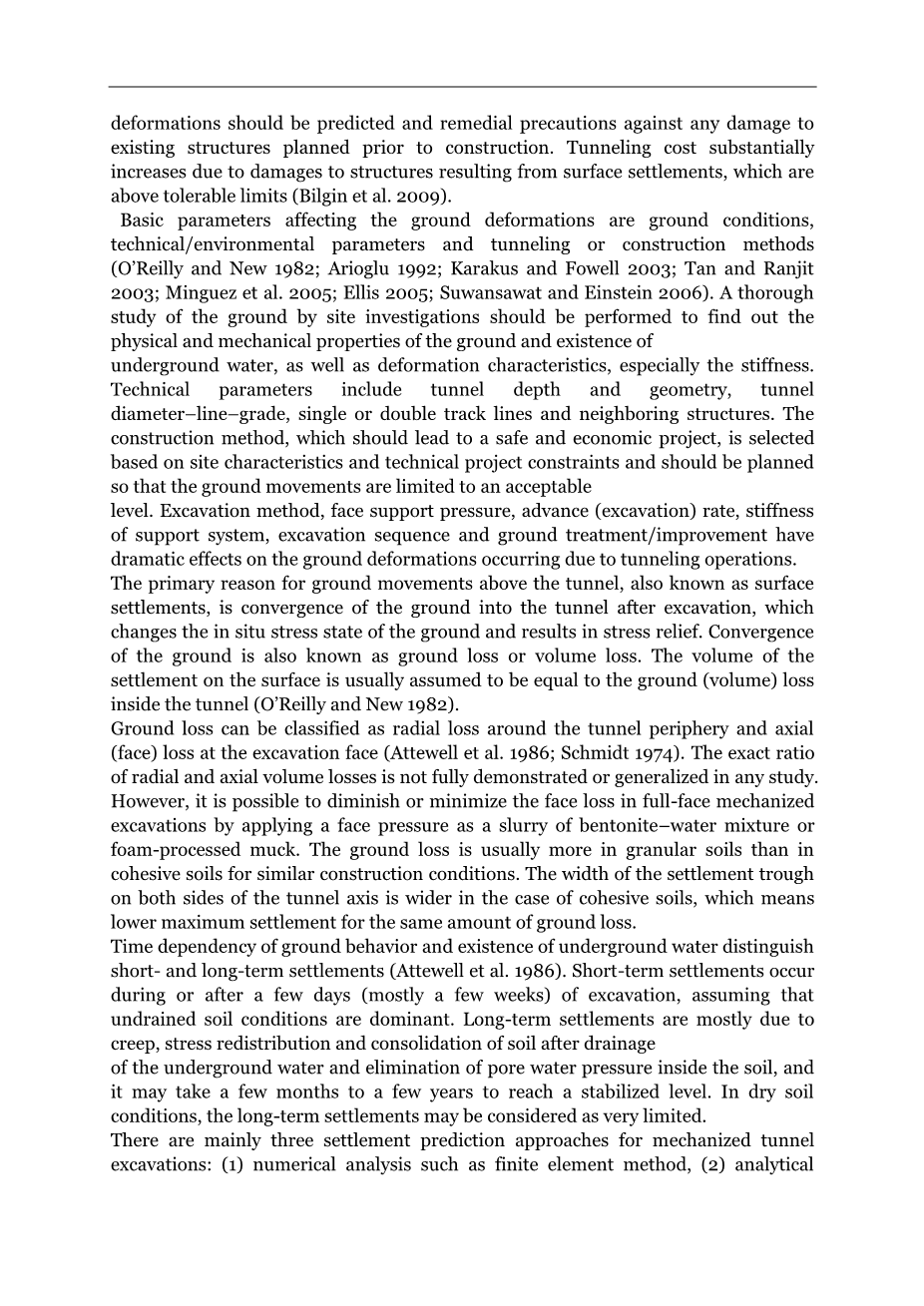外文原文
Surface settlement predictions for Istanbul Metro tunnels
excavated by EPB-TBM
S. G. Ercelebi bull; H. Copur bull; I. Ocak
Abstract In this study, short-term surface settlements are predicted for twin tunnels, which are to be excavated in the chainage of 850 to 900 m between the Esenler and Kirazlı stations of the Istanbul Metro line, which is 4 km in length. The total length of the excavation line is 21.2 km between Esenler and Basaksehir. Tunnels are excavated by employing two earth pressure balance (EPB) tunnel boring machines (TBMs) that have twin tubes of 6.5 m diameter and with 14 m distance from center to center. The TBM in the right tube follows about 100 m behind the other tube. Segmental lining of 1.4 m length is currently employed as the final support. Settlement predictions are performed with finite element method by using Plaxis finite element program. Excavation, ground support and face support steps in FEM analyses are simulated as applied in the field. Predictions are performed for a typical
geological zone, which is considered as critical in terms of surface settlement. Geology in the study area is composed of fill, very stiff clay, dense sand, very dense sand and hard clay, respectively, starting from the surface. In addition to finite element modeling, the surface settlements are also predicted by using semi-theoretical (semi-empirical) and analytical methods. The results indicate that the FE model predicts well the short-term surface settlements for a given volume loss value. The results of semi-theoretical and analytical methods are found to be in good agreement with the FE model. The results of predictions are compared and verified by field measurements. It is suggested that grouting of the excavation void should be performed as fast as possible after excavation of a section as a precaution against surface settlements during excavation. Face pressure of the TBMs should be closely monitored and adjusted for different zones.
Keywords Surface settlement prediction _ Finite element method _ Analytical method _ Semi-theoretical method _ EPB-TBM tunneling _
Istanbul Metro
Introduction
Increasing demand on infrastructures increases attention to shallow soft ground tunneling methods in urbanized areas. Many surface and sub-surface structures make underground construction works very delicate due to the influence of ground deformation, which should be definitely limited/controlled to acceptable levels. Independent of the
excavation method, the short- and long-term surface and sub-surface ground deformations should be predicted and remedial precautions against any damage to existing structures planned prior to construction. Tunneling cost substantially increases due to damages to structures resulting from surface settlements, which are above tolerable limits (Bilgin et al. 2009).
Basic parameters affecting the ground deformations are ground conditions, technical/environmental parameters and tunneling or construction methods (Orsquo;Reilly and New 1982; Arioglu 1992; Karakus and Fowell 2003; Tan and Ranjit 2003; Minguez et al. 2005; Ellis 2005; Suwansawat and Einstein 2006). A thorough study of the ground by site investigations should be performed to find out the physical and mechanical properties of the ground and existence of
underground water, as well as deformation characteristics, especially the stiffness. Technical parameters include tunnel depth and geometry, tunnel diameter–line–grade, single or double track lines and neighboring structures. The construction method, which should lead to a safe and economic project, is selected based on site characteristics and technical project constraints and should be planned so that the ground movements are limited to an acceptable
level. Excavation method, face support pressure, advance (excavation) rate, stiffness of support system, excavation sequence and ground treatment/improvement have dramatic effects on the ground deformations occurring due to tunneling operations.
The primary reason for ground movements above the tunnel, also known as surface settlements, is convergence of the ground into the tunnel after excavation, which changes the in situ stress state of the ground and results in stress relief. Convergence of the ground is also known as ground loss or volume loss. The volume of the settlement on the surface is usually assumed to be equal to the ground (volume) loss inside the tunnel (Orsquo;Reilly and New 1982).
Ground loss can be classified as radial loss around the tunnel periphery and axial (face) loss at the excavation face (Attewell et al. 1986; Schmidt 1974). The exact ratio of radial and axial volume losses is not fully demonstrated or generalized in any study. However, it is possible to diminish or minimize the face loss in full-face mechanized excavations by applying a face pressure as a slurry of bentonite–water mixture or foam-processed muck. The ground loss is usually more in granular soils than in cohesive soils for similar construction conditions. The width of the settlement trough on both sides of the tunnel axis is wider in the case of cohesive soils, which means lower maximum settlement for the same amount of ground loss.
Time dependency of ground behavior and existence of underground water distinguish short- and long-term settlements (Attewell et al. 1986). Short-term settlements occur during or after a few days (mostly a few weeks) of excavation, assuming that undrained soil conditions are dominant. Long-term settlements are mostly due to creep, stress redistribution and consolidation of soil after drainage
of the underground water and elimination of pore water pressure inside the soil, and it may take a few months to a few years to reach a stabilized level. In dry soil conditions, the long-term settlements may be considered as very limited.
There are mainly three settlement prediction approaches for mech
剩余内容已隐藏,支付完成后下载完整资料


英语译文共 26 页,剩余内容已隐藏,支付完成后下载完整资料
资料编号:[589735],资料为PDF文档或Word文档,PDF文档可免费转换为Word
以上是毕业论文外文翻译,课题毕业论文、任务书、文献综述、开题报告、程序设计、图纸设计等资料可联系客服协助查找。


